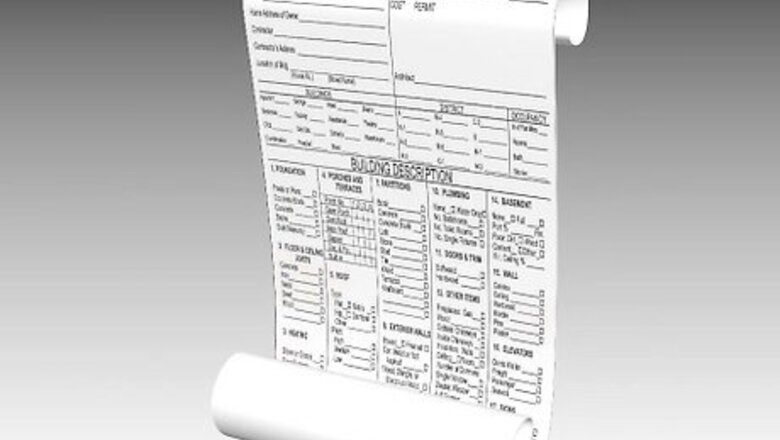
views
Planning Your Deck
Know your local building codes regarding decking. The size of your home will have an impact on how large your deck can be, as well as its shape. In most cases, your deck will also be required to support a greater load than the floors in your home. Your home owner's insurance policy may not cover an accident that occurs on your deck if you didn't build your decking to comply with the building codes in your area.
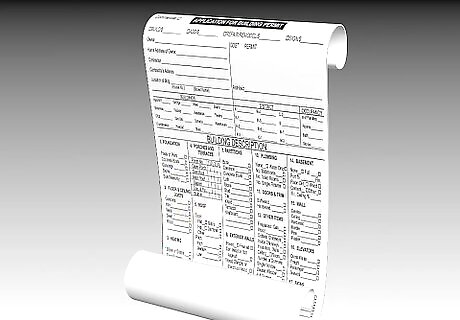
Obtain any necessary permits. Check with your local government agency regarding the need for a permit before building your deck, as well as any inspections that will be required during construction.
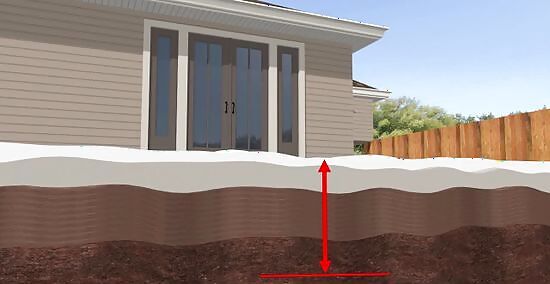
Know the depth of the frost line in your area. The frost line is the depth to which the ground freezes in winter, taken over an average of a number of years. Some building codes require that when you build a deck, the support posts be sunk to a depth below the frost line. Even if it isn't required, sinking the support posts to this depth will keep the deck from buckling when the ground expands and swells when the water in it freezes.
Decide on the size, style and placement of your deck. Your deck can either be free-standing or attached to the house. Although some building codes may be more relaxed on free-standing decks, most people find it more convenient to have their decks attached to the house. If you build your deck onto the house, you'll want to know where the rim joists and wall studs are located so you can secure the deck's ledger board, the support beam that attaches it to the house, to either of them. The size of your deck will determine the number of footings and posts you'll need to support the joists and deck boards, as well as the size and spacing of the joists and the size of the deck boards. Joists can be spaced 12, 16 or 24 inches (30, 40 or 60 centimeters) apart, however a spacing of 24 inches is most common; common sizes for joists and deck boards are listed under "Things You'll Need." The height at which you build your deck determines whether you need to include railings, posts and steps. You won't need them for a deck built just above the ground, but you will if it is higher than that. Making a preliminary sketch of what you have in mind will help you in lining up materials and construction advice.
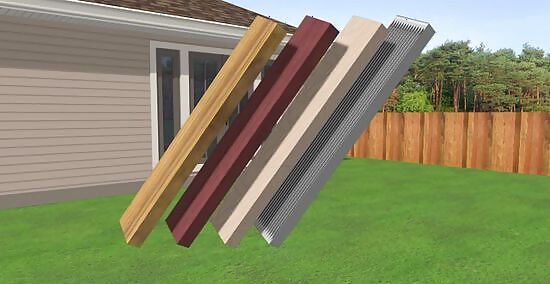
Choose the materials to make your deck from. There are a number of hardwoods and composite materials from which you can build your deck. Materials for deck boards range from the tropical Hardwood Ipe and plastic to the more traditional redwood, cedar and pine. The framing, columns and posts, however, should be pressure-treated or otherwise decay-resistant wood as required by code.
Preparing the House
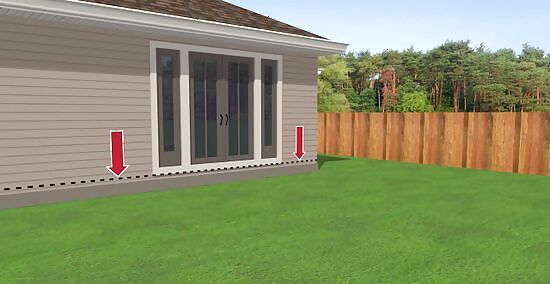
Mark the place where the top of the deck is to go. Usually, this will be the height of the interior floor and just below the threshold of any planned or current door that will open onto the deck. Use a level to draw a line on the siding the whole length of the deck.
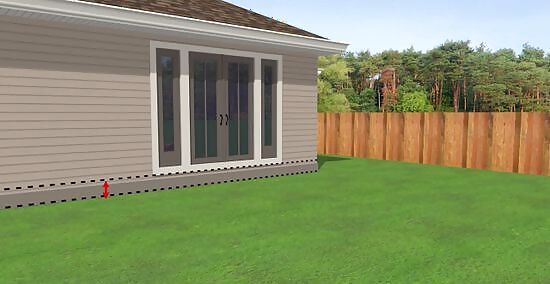
Mark the place where the bottom of the deck is to go. From the line you just marked, measure down the thickness of the deck boards (usually 1 to 1 1/2 inches, or 2.5 to 3.75 centimeters), plus the height of the ledger board. (If the ledger board is a 2 x 10, this will be 9.5 inches, or 23.75 centimeters.) Mark this line across the entire length of where the ledger board will go.
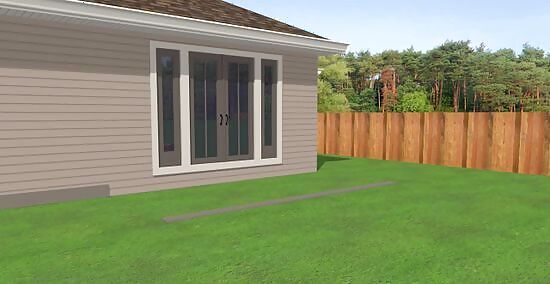
Remove the siding from where the ledger board will be mounted. If the siding is solid siding, you can cut it away with a circular saw and jigsaw, provided you don't cut into the sheathing beneath the siding. If the siding is vinyl siding, you'll need a special tool to pry up the siding; after removing it, you'll need to re-mark the lines for top of the deck and the bottom of the ledger board on the sheathing. Ignore the steps in this section if you're planning to make a free-standing deck.
Building Your Deck
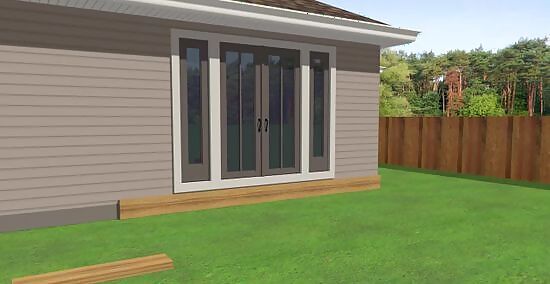
Measure and cut the ledger board. Check its fit against the house before proceeding. If you plan to cover your house's rim joists with the deck's skirting board, cut the ledger board shorter to accommodate the width of the skirting board (usually 3/4 inch, or 1.9 centimeters) on either side.
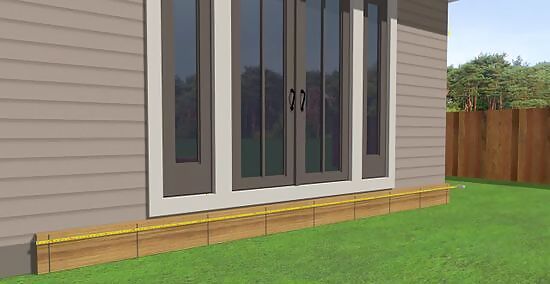
Mark off where the joists will go. First, mark off the deck's rim joists on the left edge of the ledger board. (These are usually 2 joists laid side-by-side for strength.) Then, mark the centers of where each intervening joist will go and measure half the joist's thickness from each of these marks on either side. Then, mark off the rim joists on the right edge of the ledger board. Draw lines across the ledger board surface to mark all the joist edges.
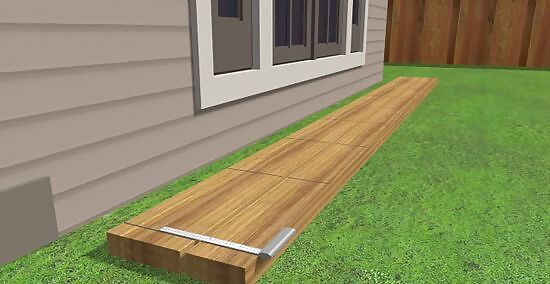
Prepare the beam that will go opposite the ledger board. Cut the beam the same length as the ledger board. If you plan to have the joists butt flush against this beam (a flush beam), then use a framing square to align the edges of both beams and then copy the marks in full. If you plan to have the joists rest on this beam instead (a dropped beam), you'll only need to have marks across the top for reference. Most building codes require the opposite beam to be twice or three times as thick as the interior joists, so as with the rim joists, you'll have to cut multiple beams and sandwich them side-by-side. (If the deck is to be a free-standing deck, the ledger board beam would also have to be sandwiched with one or two other beams for strength.)
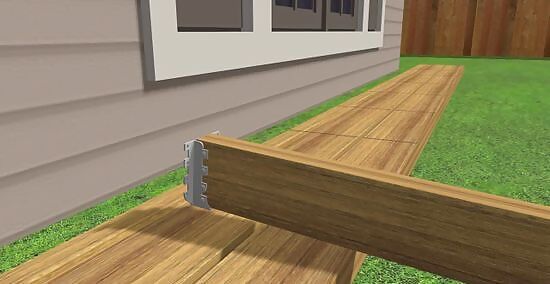
Nail the joist hangers. Check the spacing of the joist hangers with a scrap of wood the width of the joists, then nail the joist hangers in place with short, thick nails designed to secure the joists. If your opposite beam is to be a flush beam, you'll also want to attach joist hangers to the innermost member of that beam.
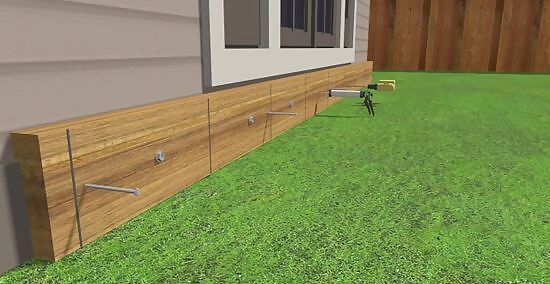
Attach the ledger board to the house. Tack the board in place temporarily with nails. Drill 1 or 2 holes between where every 2 joists will go. Apply silicone caulk to the inside of each hole, then sink a lag screw into each hole to secure the ledger board permanently. Cover the ledger board with a waterproof membrane or galvanized metal flashing. Ignore this step if the deck is to be a free-standing deck.
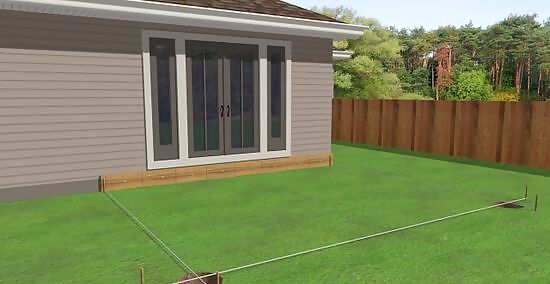
Dig holes for the footings. You can lay out the positions for the footings using string and stakes or batter boards to form a grid. Mark the footing positions on the strings, then transfer them to the ground. Dig 6 inches (15 centimeters) below the frost line for each footing with either a post-hole digger or power auger; make the bottom of each hole wider than the top. You may need to have the holes inspected for depth before you can pour the concrete.
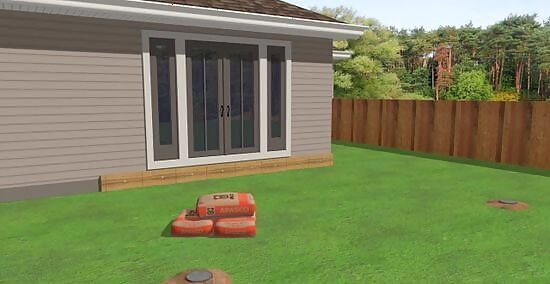
Assemble footing and pier forms. Place one in each hole and support it with loose back-fill, then trim all the piers level to support the posts evenly. Pour concrete into the holes and let it set for at least 24 hours before proceeding.
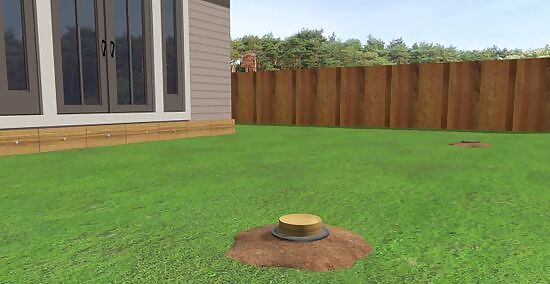
Cut and raise the posts over the piers. To anchor the posts in place, set 6-inch (15-centimeter) lengths of stainless steel rod or rebar halfway into the piers to serve as drift pins and drill holes in the post bottoms before placing them. You can also cover the pier tops with adhesive before setting the posts if the tops are wooden or use anchor brackets if the tops are concrete. Plumb the posts to be level and affix temporary braces to keep the posts from moving until the framing is in place.
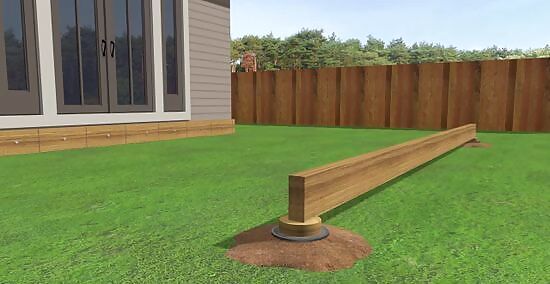
Install the opposite beam atop the posts. If your posts are tall, you may have to raise the individual members of the beam one by one instead of together. Set the beam members such that the outermost member is flush with the edge of the post. Attach the innermost member beam with toe nails or whatever connector your building codes require.
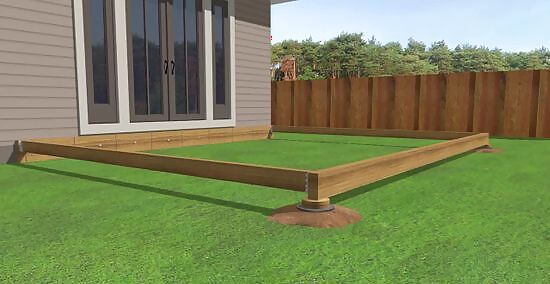
Install the rim joists. Connect the rim joists to the ledger board and innermost member of a flush opposite beam with inside corner brackets. Adjust the beam member to get it square if it isn't, then affix the reinforcing outer beam members to the innermost member with nails, screws or lag bolts.
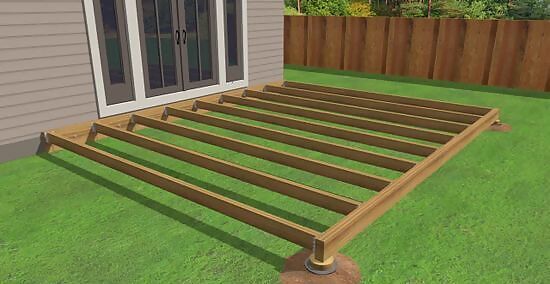
Install the interior joists. Sight down each joist edge to look for any signs of bowing (crowning). Slip them into the joist hangers on the ledger board and opposite flush beam (or atop an opposite dropped beam), crowned side up. Tap them in place if necessary, and if they're too tight, trim a bit off the ends so they slip in without excessive force. If the opposite beam is a dropped beam, toenail the joists in place.
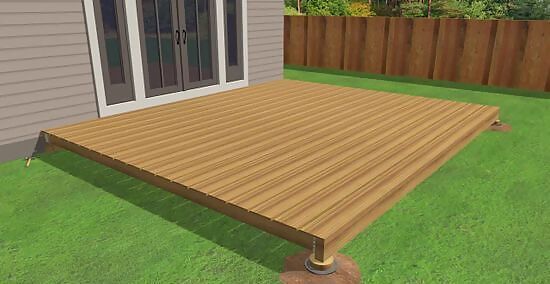
Lay down the deck boards. Measure the deck frame from the outside edge of one rim joist to the outside edge of the other and add the width of any skirting or length of any overhang to it. Cut the first two deck boards to this length, then cut off the length of any overhang from the board that will be laid next to the house. (Subsequent boards need not be cut to this length, but can be laid down first and cut flush with the first two boards later.) Set the first board against the house sheathing and the next board against it if wet and the width of a 16-penny nail apart from it if dry. Attach the boards to the joists with two nails or screws. Straighten the boards as you go with a flat bar. If you're building a wide deck, you can cut multiple deck boards to span the distance between the rim joists, with the places where two boards meet falling in the middle of a joist. Stagger these joints between each row of decking to make the deck look nicer. Periodically measure the distance from the front of the deck to each end of the last board laid. They should be equal; if not, decrease the gaps between boards slightly on the longer side and increase them slightly on the shorter side until the distances are equal again. If the last deck board is wider than the space to lay it, either narrow it or use a narrower board of the same type of decking material. If the board is narrower than the space available, take a wider board and narrow it as necessary.
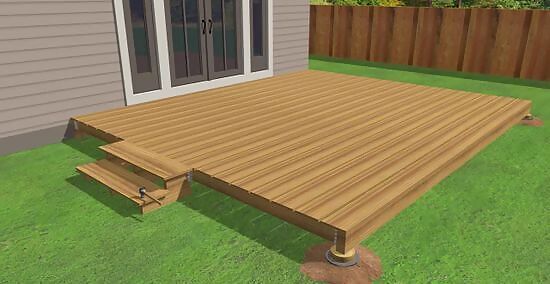
Build stairs, if necessary. If your deck is high enough to require stairs, determine the number of steps you'll need by dividing the deck height in feet by seven. If the quotient is a whole number, use the quotient as the number of steps, with a rise of 7 inches (17.5 centimeters). If the quotient includes a fraction, round to the nearest whole number to get the number of steps and divide that number into the deck height to get the rise in inches. Divide the rise into 75 to get the approximate length for each step. You'll need to have a stringer at either end of the staircase to attach the steps to and another stringer in the center if you have a wide or tall staircase. Lay the first stringer out with a framing square to find the rise and run, then transfer the marks to the other stringers. Cut out the step supports, then brace the stringers together and nail them to the deck's rim joist before securing them permanently with lag screws. Cut the steps to have a 3/4-inch (1.9-centimeter) overhang to either side of the stringer assembly to channel rain away from the stringers. Attach them to the stringers with screws or nails.
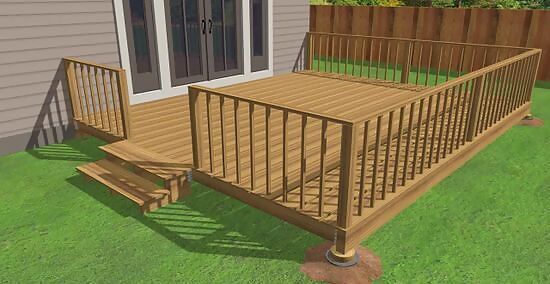
Build and install deck railings, if necessary. If your deck is more than a step high, you'll want or need to have deck railings to prevent falls. Begin by installing the corner and stair posts, plumbing them and securing them first with glue, then with either lag screws or carriage bolts. The remaining pieces—top rails, bottom rails and spindles—may be attached individually or assembled into sections and then installed as units. Measure the distance between posts to find the length of the rails and cut them to that length. Vertical spindles usually need to be spaced to no more than 4 inches (10 centimeters) apart and should be placed closer together if it will create even spacing over the entire deck. They can be attached to the rails with nails or screws, while the rails themselves attach to the posts with angle screws. (Use wooden blocks to prop up the rail sections while screwing them in.) Cut the stair posts to the correct height and angle with the help of a framing square, then install the bottom stair rails and hand rails. Figure the length of the stair rails by dividing the stair rise by the run, multiplying by the deck rail length, squaring the result, adding the square of the deck rail length and take the square root of the result. Cut the spindles to the right length, angled for the slope of the rail and install as described above for the deck spindles.
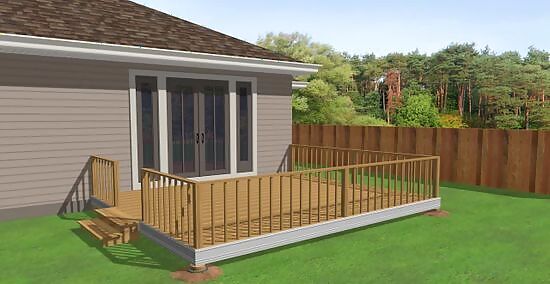
Attach skirting board, if desired. Cut the boards to cover the deck's beam and rim joists and nail them in place.




















Comments
0 comment